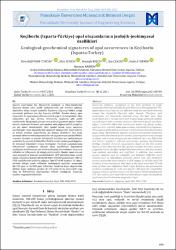| dc.contributor.author | Baspinar Tuncay, Ebru | |
| dc.contributor.author | Kuscu, Mustafa | |
| dc.contributor.author | Cengiz, Oya | |
| dc.contributor.author | Aydemir, Fatih | |
| dc.contributor.author | Raimov, Rahmen | |
| dc.contributor.author | Koken, Ekin | |
| dc.date.accessioned | 2023-04-07T08:58:48Z | |
| dc.date.available | 2023-04-07T08:58:48Z | |
| dc.date.issued | 2022 | en_US |
| dc.identifier.issn | 1300-7009 | |
| dc.identifier.issn | 2147-5881 | |
| dc.identifier.other | WOS:000918847500007 | |
| dc.identifier.uri | https://doi.org/10.5505/pajes.2021.84769 | |
| dc.identifier.uri | https://hdl.handle.net/20.500.12573/1573 | |
| dc.description.abstract | Silica-rich solutions, considered as the final products of acidic
volcanism, which started from the Late Miocene to throughout the PlioQuaternary around Isparta, are effective along the main fault observed
around the Keçiborlu (Isparta) sulfur deposit. Therefore, opal
occurrences are intensively observed along this fault zone. Opal
occurrences are in various colors such as gray, beige, yellowish, reddish,
blackish. Opals with a massive structure, observed as bands, are sharpedged, conchoidal diffraction, translucent, matte, oily glossy surface
opals are iron oxidized. Some opals contain brecciated rock fragments.
The locations of the opal occurrences in the field were determined in this
study. Using representative samples, structural and textural properties
of opals were determined by thin section, scanning electron microscopy
analyses, and mineral paragenesis was analyzed via x-ray diffraction
and Fourier transform infrared spectroscopy analyses. Geochemical
findings revealed chemical compositions. Based on the thin-section
studies, it was observed that the opalized samples lost their primary
properties due to the effect of hydrothermal solutions and they became
iron oxidized, laminated, and argillized. In addition, they contain
opaque minerals such as magnetite and hematite. Different micro
textures such as amorphous, granular, desert rose, and lepisphere
quartz associations were observed in SEM images. In the XRD and FTIR
analyzes, it was determined that most of the opals were Opal CT and
some of them were defined as Opal C type. Based on the geochemical
analyses considering Ba <120 ppm and Ca >200 ppm, the remarkable
changes in loss on ignition values, and the relative relationship between
C/T ratio and Ga, such hydrothermal alterations in opals the Keçiborlu
opals were found to have the magmatic origin. | en_US |
| dc.description.abstract | Isparta civarındaki Geç Miyosen’de başlayan ve Pliyo-Kuvaterner
boyunca devam eden asidik volkanizmanın son ürünleri şeklinde
düşünülen silisçe zengin çözeltiler Keçiborlu (Isparta) kükürt yatağı
çevresinde gözlenen ana fay boyunca etkilidir. Bundan dolayı, opal
oluşumları bu zayıf zonun yakın çevresinde yoğun olarak gözlenir. Opal
oluşumları, gri, bej, sarımsı, kırmızımsı, siyahımsı gibi çeşitli
renklerdedir. Masif yapılı, yer yer bant şeklinde gözlenen opaller keskin
kenarlı, konkoidal kırınımlı, yarı saydam, mat, yağımsı parlak yüzeyli ve
yer yer demir oksitleşmiştir. Bazı opaller breşik kayaç parçaları
içermektedir. Opal oluşumlarının sahadaki lokasyonları tespit edilmiş
ve temsili örnekler kullanılarak, söz konusu örneklerin ince kesit,
taramalı elektron mikroskop analizleri ile yapısal ve dokusal özellikleri,
x-ışınları kırınımı ve fourier dönüşümlü kızılötesi ışın spektroskopisi
analizleri ile mineral birliktelikleri belirlenmiştir. Jeokimyasal bulgular
ile kimyasal bileşimleri ortaya konmuştur. İncekesit çalışmalarında
hidrotermal çözeltilerin etkisiyle ilksel özelliklerini kaybederek
opalleşmiş örneklerin yer yer demiroksitleşmiş, laminalanma kazanmış
oldukları ve killeşmenin de olduğu gözlenmiştir. Opaller opak mineral
olan manyetit ve hematit içermektedirler. SEM görüntülerinde amorf,
taneli, çöl gülü ve lepisfer gibi farklı mikro dokular gözlenmiştir. XRD ve
FTIR analizlerinde opallerin çoğunun Opal CT ve bir kısmının da Opal C
türünde olduğu tespit edilmiştir. Jeokimyasal analizler sonucunda
Ba<120 ppm ve Ca>200 ppm miktarları, kızdırma kaybı değerlerinin
dikkate değer değişimi, gerekse de C/T oranı ile Ga arasındaki nispi
ilişki ile hidrotermal alterasyonlar dikkate alındığında Keçiborlu
opalleri magmatik kökenlidir | en_US |
| dc.description.sponsorship | TÜBİTAK 2209/A Üniversite Öğrencileri Yurtiçi Araştırma Projeleri Destek Programı | en_US |
| dc.language.iso | tur | en_US |
| dc.publisher | PAMUKKALE UNIV | en_US |
| dc.relation.isversionof | 10.5505/pajes.2021.84769 | en_US |
| dc.rights | info:eu-repo/semantics/openAccess | en_US |
| dc.subject | Keçiborlu (Isparta) | en_US |
| dc.subject | Opal | en_US |
| dc.subject | XRD | en_US |
| dc.subject | SEM | en_US |
| dc.subject | FTIR | en_US |
| dc.title | Keçiborlu (Isparta-Türkiye) opal oluşumlarının jeolojik-jeokimyasal özellikleri | en_US |
| dc.title.alternative | Geological-geochemical signatures of opal occurrences in Keciborlu (Isparta-Turkey) | en_US |
| dc.type | article | en_US |
| dc.contributor.department | AGÜ, Mühendislik Fakültesi, Malzeme Bilimi ve Nanoteknoloji Mühendisliği Bölümü | en_US |
| dc.contributor.authorID | 0000-0003-0178-329X | en_US |
| dc.contributor.institutionauthor | Koken, Ekin | |
| dc.identifier.volume | 28 | en_US |
| dc.identifier.issue | 6 | en_US |
| dc.identifier.startpage | 840 | en_US |
| dc.identifier.endpage | 850 | en_US |
| dc.relation.journal | PAMUKKALE UNIVERSITY JOURNAL OF ENGINEERING SCIENCES-PAMUKKALE UNIVERSITESI MUHENDISLIK BILIMLERI DERGISI | en_US |
| dc.relation.publicationcategory | Makale - Ulusal Hakemli Dergi - Kurum Öğretim Elemanı | en_US |


















